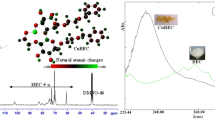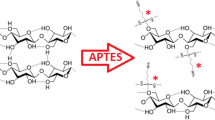Abstract
Regioselectively functionalized 3-β-alkyl ethers of cellulose (alkyl =β-pentyl, isopentyl, dodecyl) can be synthesized using 2,6-di-β-thexyldimethylsilyl cellulose as a protected intermediate. ID comparison to the corresponding 2,3,6-tri-β-alkyl ethers, the dissolution behavior and the structure ID solution of the 3-β-alkyl ethers were investigated using light scattering. The aim of the paper ID to present the first experimental and systematic work on specific properties of regioselectively modified celluloses. The results of structure investigation ID solution are discussed ID detail and lead to a primary understanding of interactions of this type of cellulosics on a molecular and supramolecular level.
Similar content being viewed by others
References
Berne B.J. and Pecora R. 1976. Dynamic Light Scattering. Wiley, London.
Berry G.C. 1966. Thermodynamic and conformational properties of polystyrene. ID Light scattering studies of linear polystyrene. J. Chem. Phys. 44: 4550-4564.
Burchard W. 1978. Light scattering technique. ID: Happey F. (ed.), Applied Fibre Science. Academic Press, London, Chapter 10, pp. 381-420.
Burchard W. 1983. Static and dynamic light scattering from branched polymers and biopolymers. Adv. Polym. Sci. 48: 1-124.
Burchard W. 1994. ID: Ross-Murphy S.B. (ed.), Physical Techniques for the Study of Food Biopolymers, Light Scattering Techniques. Blackie Academic & Professional, London, Chapter 4, pp. 154-213.
Burchard W. 2000. Structure of cellulose ID solution. Macromol. Chem. Phys. 201: 2008-2022.
Burchard W. and Schmidt M. 1979. The diffusion coefficient of branched polyvinylacetate microgels measured by quasielastic light scattering. Ber. Bunsenges. Phys. Chem. 83: 388-391.
Burchard W. and Schulz L. 1989. Lösungsstruktur von cellulose 2.5 acetaten. Das Papier 43: 665-673.
Burchard W., Schmidt M. and Stockmayer W.H. 1980. Information on polydispersity and branching from combined quasi-elastic and integrated light scattering. Macromolecules 13: 1265-1272.
Burchard W., Habermann N., Klüfers P., Seger B. and Wilhelm U. 1994. Cellulose ID Schweizer's reagent: a stable polymer complex with high chain stiffness. Angew. Chem. 106: 936-939.
Burger G., Kettenbach G. and Klüfers P. 1995. Coordinating equilibria ID transient metal based cellulose solvents. Macromol. Symp. 99: 113-126.
Dawsey T.R. and McCormick C.L. 1990. The lithium chloride/dimethylacetamide solvent for cellulose: a literature review. JMS-Rev. Macromol. Chem. Phys. C30: 405-440.
Einfeldt L., Petzold K., Günther W., Stein A., Kussler M. and Klemm D. 2001. Preparative and 1H NMR investigation on regioselective silylation of starch dissolved ID dimethylsulfoxide. Macromol. Biosci. 1(8): 341-347.
Flory P.J. 1953. Principles of Polymer Chemistry. Cornell University Press, Ithaca, NY.
Gagnaire D., Saint-Germain J. and Vincedon M. 1983. NMR evidence of hydrogen bonds ID cellulose. J. Appl. Polym. Sci. Appl. Polym. Symp. 37: 261-275.
Guinier A. 1939. La diffration des la rayon x aux très petits Angles. Ph.D. Thesis, University of Paris.
Guinier A. and Fournet G. 1955. Small Angle Scattering of X-Rays. Wiley, New York.
Helfrich B. and Koester H. 1924. Äther des Triphenyl-carbinols mit cellulose und Stärke. Berichte 57: 587-591.
Huglin M.B. 1972. Light Scattering from Polymer Solutions. Academic Press, London.
Jeffrey G.A. and Saenger W. 1994. Hydrogen Bonding ID Biological Structures. Springer Verlag, Berlin.
Kamide K. and Saito L. 1987. Cellulose and cellulose derivatives; recent advances ID physical chemistry. Adv. Polym. Sci. 83: 1-56.
Kamide K., Saito M., Kowsaka K. and Okajima K. 1987a. A further study on solvation ID cellulose triacetate solutions by pulse-Fourier 1H and 13C NMR method. Polymer J. 19: 1377-1383.
Kamide K., Okajima K., Kowsaka K. and Matsui T. 1987b. Solubility of cellulose acetate prepared by different methods and its correlations with average acetyl group distribution on glucopyranose units. Polymer J. 19: 1405-1412.
Kettenbach G., Klüfers P. and Mayer P. 1997. Deprotonation pattern of disaccharides ID coordinating cellulose solvents: a status report. Macromol. Symp. 120: 291-301.
Klemm D. and Einfeldt L. 2001. Structure design of polysaccharides: novel concepts, selective syntheses, high value application. Macromol. Symp. 163: 35-47.
Klemm D., Philipp B., Heinze T., Heinze U. and Wagenknecht W. 1998. Comprehensive Cellulose Chemistry, 1st edn, Vol. 2. Wiley-VCH, Weinheim, Germany.
Kondo T. 1993. Preparation of 6-β-alkylcelluloses. Carbohydr. Res. 238: 231-240.
Kondo T. 1997. The relationship between intramolecular hydrogen bonds and certain physical properties of regioselectively substituted cellulose derivatives. J. Polym. Sci. B: Polym. Phys. 35: 717-723.
Kondo T. and Gray D.G. 1991. The preparation of β-methyland β-ethyl-celluloses having controlled distribution of substituents. Carbohydr. Res. 220: 173-183.
Kondo T. and Gray D.G. 1992. Facile method for preparation of tri-β-(alkyl)cellulose. J. Appl. Polym. Sci. 45: 417-423.
Koppel D.E. 1972. Analysis of macromolecular polydispersity ID intensity correlation spectroscopy. The method of cumulants. J. Chem. Phys. 57: 4814-4820.
Koschella A., Heinze T. and Klemm D. 2001. First synthesis of 3-β-functionalized cellulose ethers via 2,6-di-β-protected silyl cellulose. Macromol. Biosci. 1: 49-54.
Nilsson S., Thuresson K., Lindman B. and Nyström B. 2000. Association ID mixtures of hydrophobically modified polymer and surfactant ID dilute and semidilute aqueous solutions. A rheology and PFG NMR self-diffusion investigation. Macromolecules 33: 9641-9649.
Perrin F. 1936. Mouvement Brownien d'un ellipsoide, ID. Ratation libre et dépolarisation des fluoerescences. Translation et diffusion de molécules ellipsoides. J. Phys. Radium 7: 1-11.
Petzold K., Einfeldt L., Günther W., Stein A. and Klemm D. 2001. Regioselective functionalization of starch: synthesis and 1H NMR characterization of 6-β silylethers. Biomacromolecules 2(3): 965-969.
Pfannemueller B. and Berg A. 1979a. Chemical synthesis of branched polysaccharides. 7. A study of degradation of polysaccharide backbone on introducing glycosidic bonds. Macromol. Chem. 180: 1183-1199.
Pfannemueller B. and Berg A. 1979b. Chemical synthesis of branched polysaccharides. 8. Comparative studies on derivatives of amylose and cellulose with different substituents at C-6 by optical rotatory dispersion and circular dichroism. Macromol. Chem. 180: 1201-1213.
Pfannemüller B., Richter G.C. and Husemann E. 1975. Synthesis of comb-like derivatives of amylose and cellulose having (1,6)-linked D-glucose side-chains. Carbohydr. Res. 43: 151-161.
Potthast A., Rosenau T., Buchner R., Roeder T., Ebner G., Bruglachner H., Sixta H. and Kosma P. 2002. The cellulose solvent N,N-dimethylacetaminide/lithium chloride revisited: the effect of water on physico-chemical properties and chemical stability. Cellulose 9: 41-53.
Pusey P.N., Koppel D.E., Schaefer D.W., Cameini-Otero R.D. and Koenig S.H. 1974. Intensity fluctuation spectroscopy of laser light scattered by solutions of spherical viruses: R 17, Q beta, BSV, PM 2, and T 7. ID Light-scattering technique. Biochemistry 13: 952-960.
Riseman J. and Kirkwood J.G. 1950. The intrinsic viscosity, translational and rotatory diffusion constants of rod-like macromolecules ID solution. J. Chem. Phys. 19: 512-528.
Russo P.S. 1993. Dynamic light scattering from rigid and nearly rigid rods. ID: Brown W. (ed.), Dynamic Light Scattering. Clarendon Press, Oxford, UK.
Saalwächter K., Burchard W., Klüfers P., Dugarmaa S. and Klemm D. 2000. Cellulose solutions ID water containing metal complexes. Macromolecules 33: 4094-4107.
Schmidt M., Nerger D. and Burchard W. 1979. Quasi-elastic light scattering from branched polyvinylacetate and polyvinylacetate microgels. Polymer 20: 582-588.
Schulz L. and Burchard W. 1993. Lösungsstruktur verschiedener cellulosederivate. Das Papier 47: 1-10.
Schulz L., Burchard W. and Dönges R. 1996. Evidence of supramolecular structures of cellulose derivatives ID solution. ID: Heinze T.J. and Glasser W.G. (eds), Cellulose Derivatives: Modification, Characterization and Nanostructures. ACS Symposium Series, Vol. 688, pp. 218-238.
Schulz L., Seger B. and Burchard W. 2000. Structure of cellulose ID solution. Macromol. Chem. Phys. 201: 2008-2022.
Thuresson K. and Lindman B. 1999. Association ID nonionic cellulose ether solutions due to microcrystallites. Colloids and Surfaces A: Physicochemical and Engineering Aspects 159: 219-226.
Zimm B.H. 1948. Apparatus and methods for measurement and interpretation of the angular variation of light scattering. J. Chem. Phys. 16: 1099-1116.
Zugenmaier P. 1983. Structural investigations on cellulose derivatives. J. Appl. Polym. Sci. Appl. Polym. Symp. 37: 223-238.
Zugenmaier P. 1985. ID: Burchard W. (ed.), Polysaccharide, Konformations-und Packungsanalyse von Polysacchariden. Springer Verlag, Berlin, Germany, pp. 260-279.
Zugenmaier P. 1989. Neuere ergebnisse von strukturuntersuchungen an kristallinen und flüssigkristallinen cellulose-und cellulosederivaten. Das Papier 43: 658-664.
Zugenmaier P. and Klohr E. 1997. Polymer-solvent interaction of molecular dispersed and supramolecular structures of cellulose urethanes. Macromol. Symp. 120: 219-230.
Author information
Authors and Affiliations
Rights and permissions
About this article
Cite this article
Petzold, K., Klemm, D., Heublein, B. et al. Investigations on structure of regioselectively functionalized celluloses ID solution exemplified by using 3-β-alkyl ethers and light scattering. Cellulose 11, 177–193 (2004). https://doi.org/10.1023/B:CELL.0000025391.25835.e7
Issue Date:
DOI: https://doi.org/10.1023/B:CELL.0000025391.25835.e7




